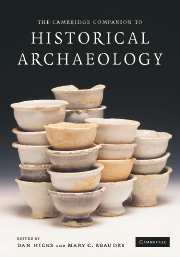Book contents
- Frontmatter
- Dedication
- Contents
- List of figures
- List of tables
- List of contributors
- Acknowledgements
- List of abbreviations
- 1 Introduction: the place of historical archaeology
- PART I ARCHAEOLOGY AND HISTORY
- PART II KEY THEMES IN HISTORICAL ARCHAEOLOGY
- 5 Historical archaeology and colonialism
- 6 Urban historical archaeology
- 7 Archaeology, heritage and the recent and contemporary past
- 8 Marxism and capitalism in historical archaeology
- 9 Historical archaeology and industrialisation
- 10 Historical maritime archaeology
- PART III HISTORICAL ARCHAEOLOGY AND MATERIAL CULTURE
- PART IV HISTORICAL ARCHAEOLOGY AND LANDSCAPES
- PART V HISTORICAL ARCHAEOLOGY AND BUILDINGS
- References
- Index
10 - Historical maritime archaeology
from PART II - KEY THEMES IN HISTORICAL ARCHAEOLOGY
Published online by Cambridge University Press: 05 July 2015
- Frontmatter
- Dedication
- Contents
- List of figures
- List of tables
- List of contributors
- Acknowledgements
- List of abbreviations
- 1 Introduction: the place of historical archaeology
- PART I ARCHAEOLOGY AND HISTORY
- PART II KEY THEMES IN HISTORICAL ARCHAEOLOGY
- 5 Historical archaeology and colonialism
- 6 Urban historical archaeology
- 7 Archaeology, heritage and the recent and contemporary past
- 8 Marxism and capitalism in historical archaeology
- 9 Historical archaeology and industrialisation
- 10 Historical maritime archaeology
- PART III HISTORICAL ARCHAEOLOGY AND MATERIAL CULTURE
- PART IV HISTORICAL ARCHAEOLOGY AND LANDSCAPES
- PART V HISTORICAL ARCHAEOLOGY AND BUILDINGS
- References
- Index
Summary
Maritime archaeology studies human interactions with oceans, rivers and lakes in the past. In the historical period, maritime archaeology focuses upon the underwater remains of ships, boats or other watercraft or vessels and aircraft. It includes the study of objects and human remains that survive within such vessels as well as cultural material that was accidentally dropped, lost overboard or deliberately deposited into the water body. It also includes the remains of structures that were originally built wholly or partly underwater (such as bridges, piers, jetties and wharves) as well as the physical remains of human activity that originally took place on dry or marshy land but that has subsequently been inundated, either by rising water levels or by marine (or fluvial) erosion. Historical maritime archaeologists also increasingly examine terrestrial sites, structures and landscapes: places that are not underwater but that are related to maritime activities such as lighthouses, port constructions, shore-based whaling stations or wider coastal, lakeside or riverside maritime landscapes.
Maritime archaeology includes the overlapping fields of underwater archaeology, marine archaeology and nautical archaeology. Underwater archaeology is limited to material that survives in submerged environments: such evidence may exist beneath fresh (inland) waters or salt (marine) waters. It may be visible on the bed of the water body (i.e. seabed) or buried beneath sediment. The term ‘underwater archaeology’ simply refers to the environment in which the practice of archaeology is undertaken: an environment that often brings significant technical difficulties and high costs of research. Marine archaeology examines material remains that survive in marine (saltwater) environments, while nautical archaeology studies ships and shipbuilding, using not only underwater remains but also other material evidence such as ship burials, shipwreck remains in the terrestrial landscapes or shipyards. By drawing together these materials with other sources of terrestrial and documentary evidence, historical maritime archaeology has made many contributions to historical archaeology, playing an important part in the development of the discipline and increasingly providing distinctive interpretive frameworks that emphasise interregional and international connectedness and interactions in the past.
- Type
- Chapter
- Information
- The Cambridge Companion to Historical Archaeology , pp. 168 - 188Publisher: Cambridge University PressPrint publication year: 2006
- 20
- Cited by



